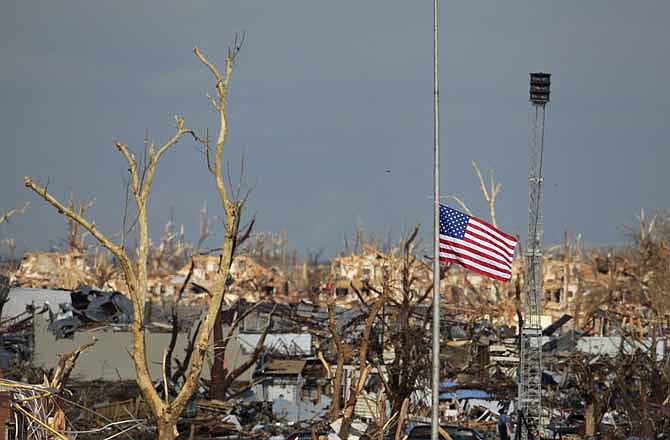Warnings sent directly to cell phones and broadcast over the airwaves can provide a detailed heads-up before dangerous storms. But for many parts of Tornado Alley, storm sirens remain so ubiquitous that one official says the pole they sit on could almost be called the state tree of Kansas.
Many who live where tornadoes are most common rely on storm sirens - despite the risk of mechanical problems, damage from the same storms that trigger the sirens and the oft-repeated warning that people should not expect to hear the wailing tone inside well-insulated, modern homes.
Even as emergency management officials and meteorologists also urge the use of weather radios and subscriptions to phone weather alerts, sirens remain an important part of communities' warning systems. So much so that some cities and counties are considering upgrades.
Work started this past week on a roughly $200,000 project in Joplin that involves upgrading, replacing and adding tornado sirens. It comes about a year after a deadly storm killed 161 people in the southwestern Missouri community. Elsewhere, officials in Cole County, which includes the Missouri Capitol, are considering whether to place sirens in rural areas outside Jefferson City.
In Kansas, Sedgwick County is completing an upgrade that will allow sirens to be triggered individually. That project was originally expected to cost about $1.25 million but now is expected to be completed for around $900,000.
Andy Bailey, the warning coordination meteorologist for the National Weather Service in Pleasant Hill, Mo., said too many people fail to realize the warning sirens are not aimed at people who are inside or asleep. But he said sirens still have a role in protecting communities.
"I don't think there's anything wrong with a community maintaining and improving their siren systems," Bailey said. "The public is not going to allow you to remove them, so I think your best course of action is to make them as modern and as reliable as possible. So communities that are investing and spending money in those sorts of things is actually a good thing, and they're doing their part."
Sirens are anything but foolproof.
Shortly after a deadly tornado earlier this spring in Woodward, Okla., officials said a tower responsible for sending a repeating signal to the community's sirens was knocked offline by lightning. Residents reported hearing mangled sirens before the community was struck by a tornado. The town's police chief said it seemed the "hand of God" helped prevent further destruction given the crippled sirens and the twister's nighttime arrival.
During the same weekend outbreak, the police chief in Creston, Iowa, said he first learned of the weather danger after receiving a call from a local hospital where the storm already had damaged its roof and blown out windows.
Despite the limitations, many still expect to hear a warning from sirens when ominous clouds turn dangerous.
Demands from residents in one Wisconsin community prompted a Milwaukee suburb to move forward with plans for a $100,000 upgrade. Officials briefly had considered whether the required changes were worth the expense given media coverage of weather and new methods for communicating warnings.
Brookfield, Wis., Mayor Steve Ponto said it was clear many residents believe sirens are necessary for safety.
"I think some people think that the media sort of overhypes the weather. And what they really count on is when the government starts these sirens. Then they know it's serious," Ponto said. "It was a question of if there is a more effective way of notifying people, giving them more specific information. But in fact, people want this."
Other communities also have made improvements such as adding backup power sources and better monitoring systems. One manufacturer of weather, tsunami, industrial and other early warning systems said there has been interest in communities from Wisconsin to Texas to update sirens that may be decades old and sometimes date back close to World War II.
Ralph Nichols, sales director for Massachusetts-based Acoustic Technology Inc., said outdoor warning sirens play an important role in an emergency system that should include multiple ways to get alerts. Sirens provide warning to people who do not have mobile phones or cell phone reception and don't require people to sign up for special services. They also can be programmed to repeat verbal instructions.
"When you hear something, that really generates a response - whether you're crazy enough to want to stay and see a tornado or head for shelter," Nichols said.
Improvements to the warning system are a priority in Joplin, where the city commemorated the first anniversary of last year's destructive tornado and is seeking to prevent a repeat tragedy.
Keith Stammer, the emergency management director for Joplin and Jasper County, said sirens can be tested silently, reducing how often they are sounded and preventing people from becoming desensitized to them. The sirens also will be connected to the electrical grid, have solar panels and a battery backup.
Not improving sirens "would leave a hole, just like not having a weather radio in the house would leave a hole, just like not having some form of communication to your phone would leave a hole," Stammer said. "What we're trying to do is do overlays of methods of warnings and communications in the hopes that we can catch everybody."

